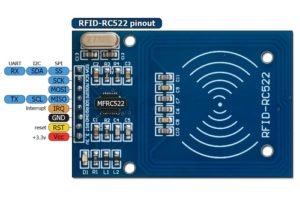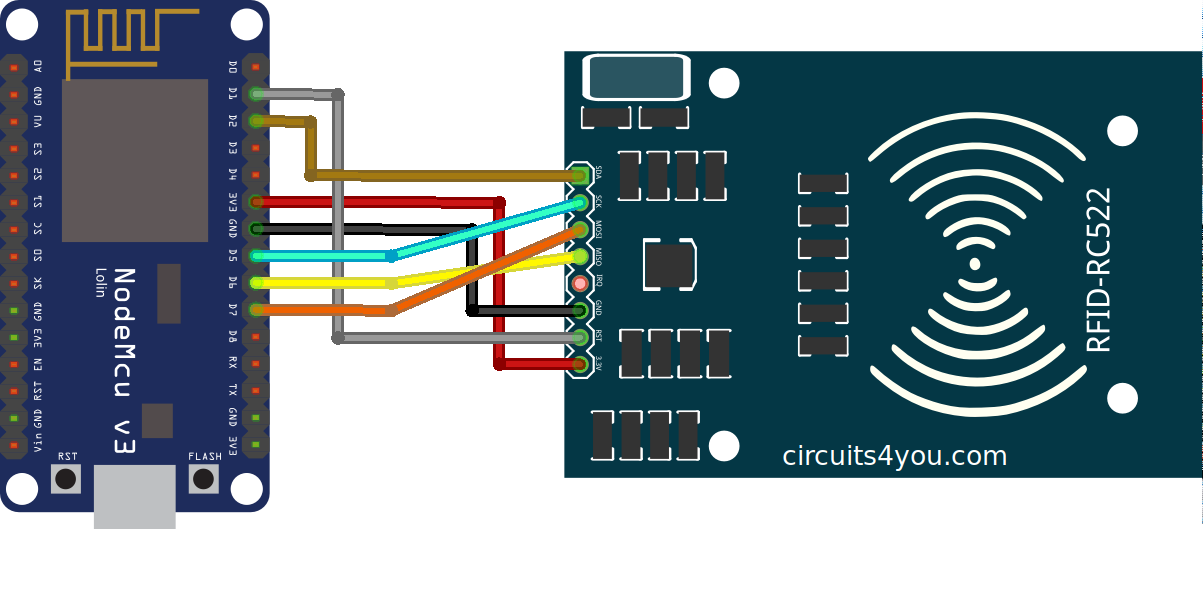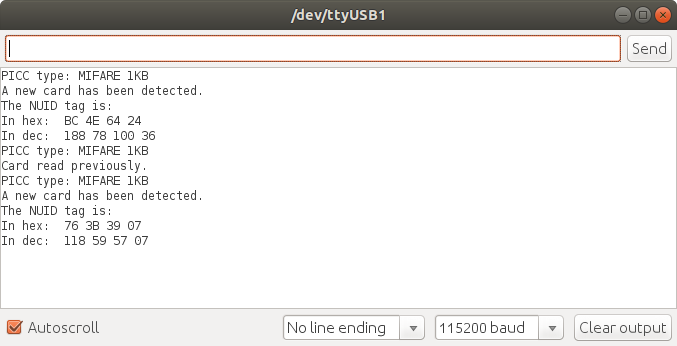/*
* ----------------------------------------------------------------------
* Example program showing how to read new NUID from a PICC to serial.
* ----------------------------------------------------------------------
* https://circuits4you.com
*
* RC522 Interfacing with NodeMCU
*
* Typical pin layout used:
* ----------------------------------
* MFRC522 Node
* Reader/PCD MCU
* Signal Pin Pin
* ----------------------------------
* RST/Reset RST D1 (GPIO5)
* SPI SS SDA(SS) D2 (GPIO4)
* SPI MOSI MOSI D7 (GPIO13)
* SPI MISO MISO D6 (GPIO12)
* SPI SCK SCK D5 (GPIO14)
* 3.3V 3.3V 3.3V
* GND GND GND
*/
#include <SPI.h>
#include "MFRC522.h"
/* Wiring RFID RC522 module
=============================================================================
GND = GND 3.3V = 3.3V
The following table shows the typical pin layout used:
Signal MFRC522 WeMos D1 mini NodeMcu Generic
RST/Reset RST D3 [1] D3 [1] GPIO-0 [1]
SPI SS SDA [3] D8 [2] D8 [2] GPIO-15 [2]
SPI MOSI MOSI D7 D7 GPIO-13
SPI MISO MISO D6 D6 GPIO-12
SPI SCK SCK D5 D5 GPIO-14
[1] (1, 2) Configurable, typically defined as RST_PIN in sketch/program.
[2] (1, 2) Configurable, typically defined as SS_PIN in sketch/program.
[3] The SDA pin might be labeled SS on some/older MFRC522 boards
=============================================================================
*/
#define RST_PIN D3 // RST-PIN für RC522 - RFID - SPI - D3
#define SS_PIN D8 // SDA-PIN für RC522 - RFID - SPI - D8
MFRC522 rfid(SS_PIN, RST_PIN); // Instance of the class
MFRC522::MIFARE_Key key;
// Init array that will store new NUID
byte nuidPICC[4];
//===================================================================================
/**
* Helper routine to dump a byte array as hex values to Serial.
*/
void printHex(byte *buffer, byte bufferSize) {
for (byte i = 0; i < bufferSize; i++) {
Serial.print(buffer[i] < 0x10 ? " 0" : " ");
Serial.print(buffer[i], HEX);
}
}
//===================================================================================
/**
* Helper routine to dump a byte array as dec values to Serial.
*/
void printDec(byte *buffer, byte bufferSize) {
for (byte i = 0; i < bufferSize; i++) {
Serial.print(buffer[i] < 0x10 ? " 0" : " ");
Serial.print(buffer[i], DEC);
}
}
//===================================================================================
//===================================================================================
void setup() {
Serial.begin(115200);
SPI.begin(); // Init SPI bus
rfid.PCD_Init(); // Init MFRC522
for (byte i = 0; i < 6; i++) {
key.keyByte[i] = 0xFF;
}
Serial.println(F("This code scan the MIFARE Classsic NUID."));
Serial.print(F("Using the following key:"));
printHex(key.keyByte, MFRC522::MF_KEY_SIZE);
Serial.println();
}
//===================================================================================
void loop() {
// Look for new cards
if ( ! rfid.PICC_IsNewCardPresent())
return;
// Verify if the NUID has been readed
if ( ! rfid.PICC_ReadCardSerial())
return;
Serial.print(F("PICC type: "));
MFRC522::PICC_Type piccType = rfid.PICC_GetType(rfid.uid.sak);
Serial.println(rfid.PICC_GetTypeName(piccType));
// Check is the PICC of Classic MIFARE type
if (piccType != MFRC522::PICC_TYPE_MIFARE_MINI &&
piccType != MFRC522::PICC_TYPE_MIFARE_1K &&
piccType != MFRC522::PICC_TYPE_MIFARE_4K) {
Serial.println(F("Your tag is not of type MIFARE Classic."));
return;
}
if (rfid.uid.uidByte[0] != nuidPICC[0] ||
rfid.uid.uidByte[1] != nuidPICC[1] ||
rfid.uid.uidByte[2] != nuidPICC[2] ||
rfid.uid.uidByte[3] != nuidPICC[3] ) {
Serial.println(F("A new card has been detected."));
// Store NUID into nuidPICC array
for (byte i = 0; i < 4; i++) {
nuidPICC[i] = rfid.uid.uidByte[i];
}
Serial.println(F("The NUID tag is:"));
Serial.print(F("In hex: "));
printHex(rfid.uid.uidByte, rfid.uid.size);
Serial.println();
Serial.print(F("In dec: "));
printDec(rfid.uid.uidByte, rfid.uid.size);
Serial.println();
}
else Serial.println(F("Card read previously."));
// Halt PICC
rfid.PICC_HaltA();
// Stop encryption on PCD
rfid.PCD_StopCrypto1();
}
//===================================================================================






